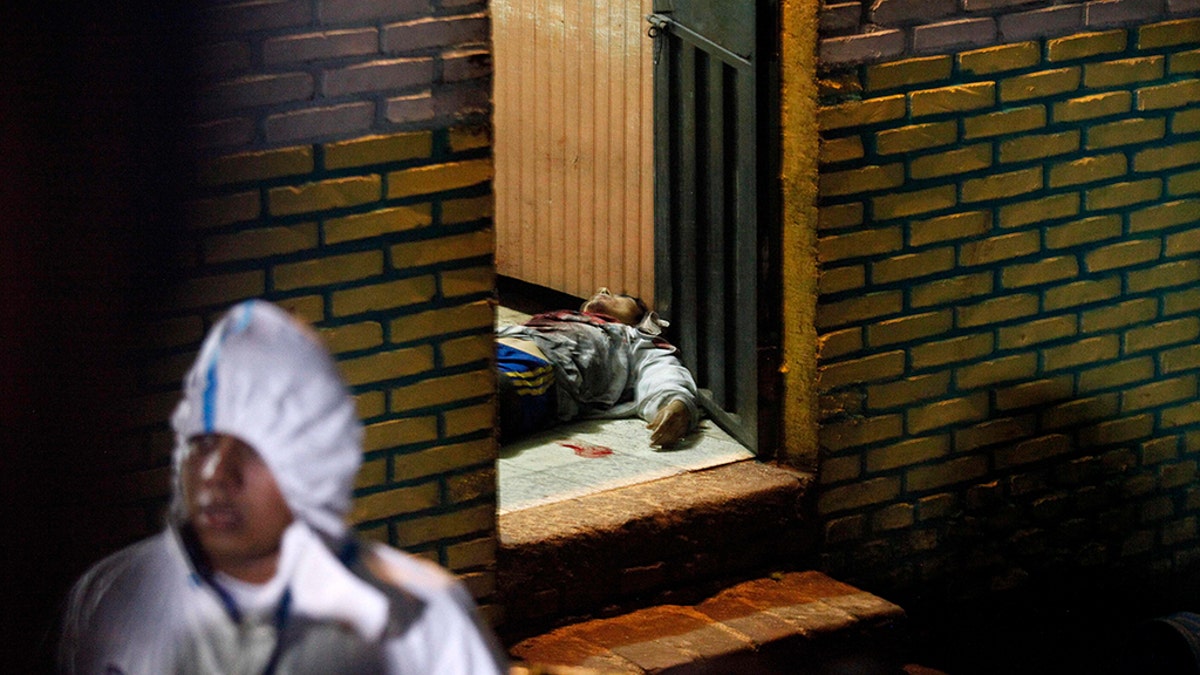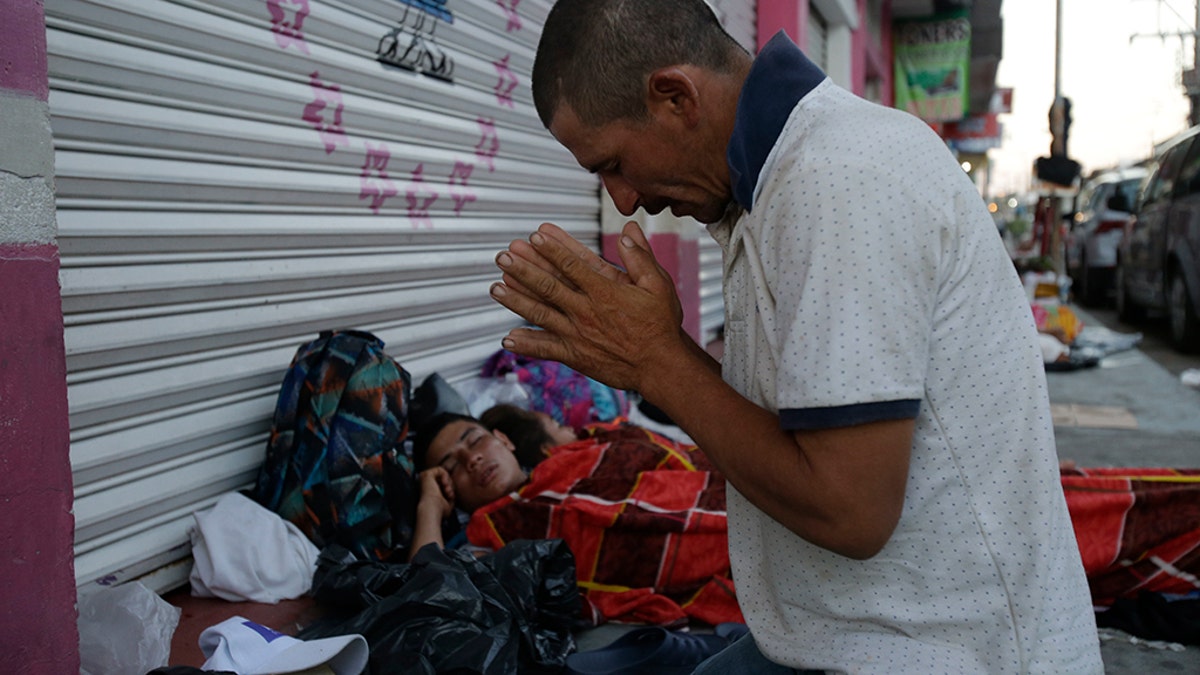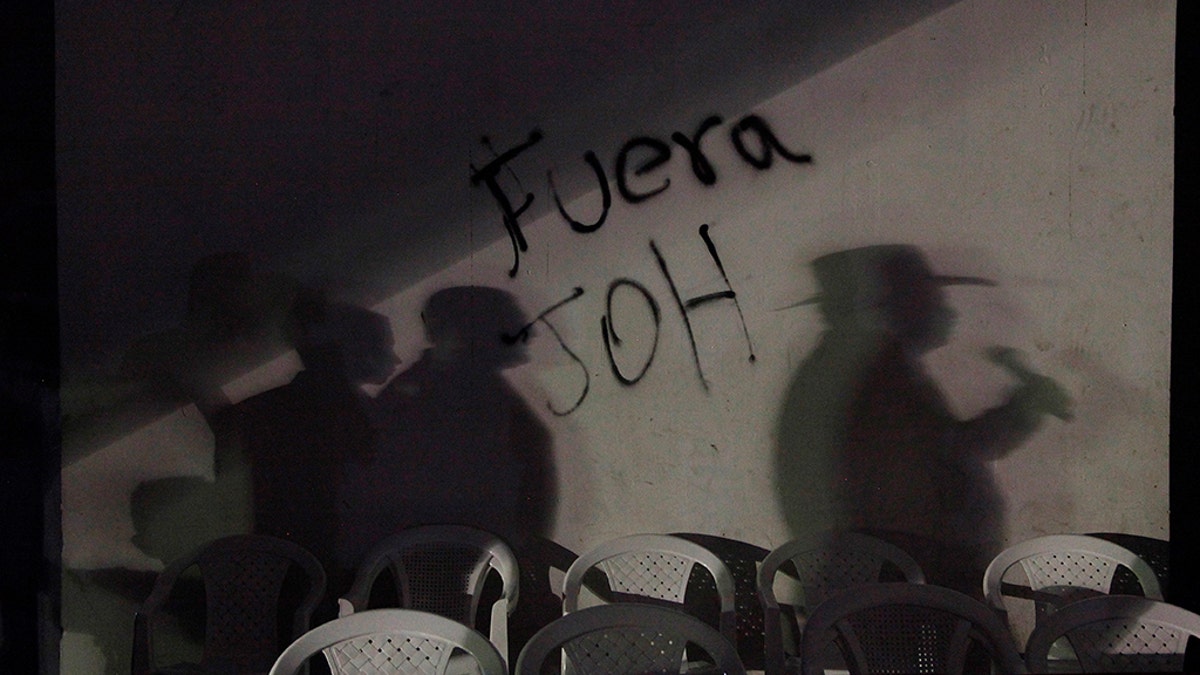
A body is stretched out at the door of a bar in the community of Comayaguela, Honduras, on Friday. At least eight people were killed and two others wounded at the bar that day, police say. (AP Photo/Fernando Antonio)
A caravan of some 7,000 migrants that originated in Central America is advancing through southern Mexico, intent on the U.S. border. The vast majority of participants, still more than 1,000 miles from their goal, are from Honduras, a country of nine million people struggling with crime and extreme poverty.
The caravan has advanced about 45 miles since crossing the border from Guatemala, and still must traverse roughly 1,000 miles to reach the closest U.S. border crossing at McAllen, Texas — more than twice that to reach the Tijuana-San Diego crossing.
Many in the caravan have little chance of qualifying for asylum, even if they do make it, as the United States does not consider things like fleeing from poverty or gang violence as a qualifying factor.
President Trump has seized on the phenomenon and made it a rallying call for his Republican base ahead of the Nov. 6 midterm elections.
Trump has blamed Democrats for what he says are weak immigration laws, claiming — without putting forth evidence — that MS-13 gang members and unknown “Middle Easterners” were hiding among the migrants.
As for those from Honduras, a bleak combination of powerful drivers like poverty and gang violence — leads many to see emigration as the only possibility for a decent life, and an estimated 750,000 Hondurans live outside the country, including nearly 600,000 in the United States, according to the International Organization for Migration.
Nearly two-thirds of Hondurans, or almost 5.5 million people, live in poverty, according to the World Bank. In rural areas, one in every five Hondurans live in extreme poverty.
Per capita income averages just $120 per month.
The World Bank said Honduras has “the highest levels of economic inequality” in Latin America.
The Inter-American Commission on Human Rights said in August that the situation creates a system that only benefits an elite minority with close ties to the highest political and economic levels.

Marvin Sanabria, a Central American migrant traveling with a caravan to the U.S., kneels in prayer after waking up, in Huixtla, Mexico, Tuesday, Oct. 23, 2018. The caravan, estimated to include more than 7,000 people, had advanced but still faced more than 1,000 miles, and likely much further, to the end of the journey. (AP Photo/Moises Castillo)
San Pedro Sula, the country’s second-largest city, where the caravan started as a relatively small group of about 160 people, has for years been considered one of the most dangerous cities in the world.
The rest of Honduras isn’t much better — in 2015, it registered 60 murders per 100,000 inhabitants, according to the United Nations.
And even though that has decreased to about 43 per 100,000 people today, according to Honduras’ National Autonomous University, many Hondurans said that has been achieved through heavy-handed tactics that result in excessive force and human rights violations.
Highly organized street gangs known as “maras” control large swaths of territory where the government is virtually absent.
Along Honduras’ Caribbean coast, drug traffickers operate with impunity, using the country as a shipping point for cocaine moving from South America to the United States, according to the U.N. The corruption that has reached high into successive governments has reduced confidence in public institutions like the police.
The conditions are often worse for children and teens, likely explaining why so many emigrate, either alone or in family units. Teen boys are frequently pressured to join gangs and threatened with death if they don’t, while teen girls are pressured to become gang members’ “girlfriends,” and face rape or murder if they refuse.
According to the International Organization for Migration, 4,700 minors were returned to Honduras in the first six months of 2018 — the same as in all of 2017. Most children start elementary school, but half quit by the time they turn 12. Only one in four will go to high school, often because they need to work to earn money for their families.
Women face high levels of violence in Honduras. In 2015 there were 417 killings of women directly related to their gender, including as a result of domestic violence, according to the most recent U.N. statistics. Eighty-nine of those killings were in San Pedro Sula. The Inter-American Commission on Human Rights said that 90 percent of such killings go unpunished. Honduras also has the second-highest adolescent birth rate in Latin America.

FILE - In this Feb. 3, 2018 file photo, the shadow of ousted Honduran President Manuel Zelaya is cast on a wall covered by the message "Get out JOH," referring to President Juan Orlando Hernandez, in Central Park, Tegucigalpa, Honduras. Since then-President Manuel Zelaya was ousted in a coup in 2009, the country’s political situation has been tense. The polarization increased after the November 2017 election in which current President Juan Orlando Hernandez was re-elected in a result marred by electoral irregularities, and denounced by his opponent as outright fraud. Extensive protests over the election were repressed with “indiscriminate and excessive use of force,” according to the Inter-American Commission on Human Rights. (AP Photo/Fernando Antonio, File)
Since then-President Manuel Zelaya was ousted in a coup in 2009, the country’s political situation has been tense. The polarization increased after the November 2017 election in which current President Juan Orlando Hernandez was reelected in a result marred by irregularities, and denounced by his opponent as outright fraud.
Extensive protests over the election were repressed with “indiscriminate and excessive use of force,” according to the Inter-American Commission on Human Rights. Some migrants have cited the political atmosphere and persecution of government opponents for their decision to migrate.
Fox News’ Paulina Dedaj and Andrew O’Reilly and The Associated Press contributed to this report.
